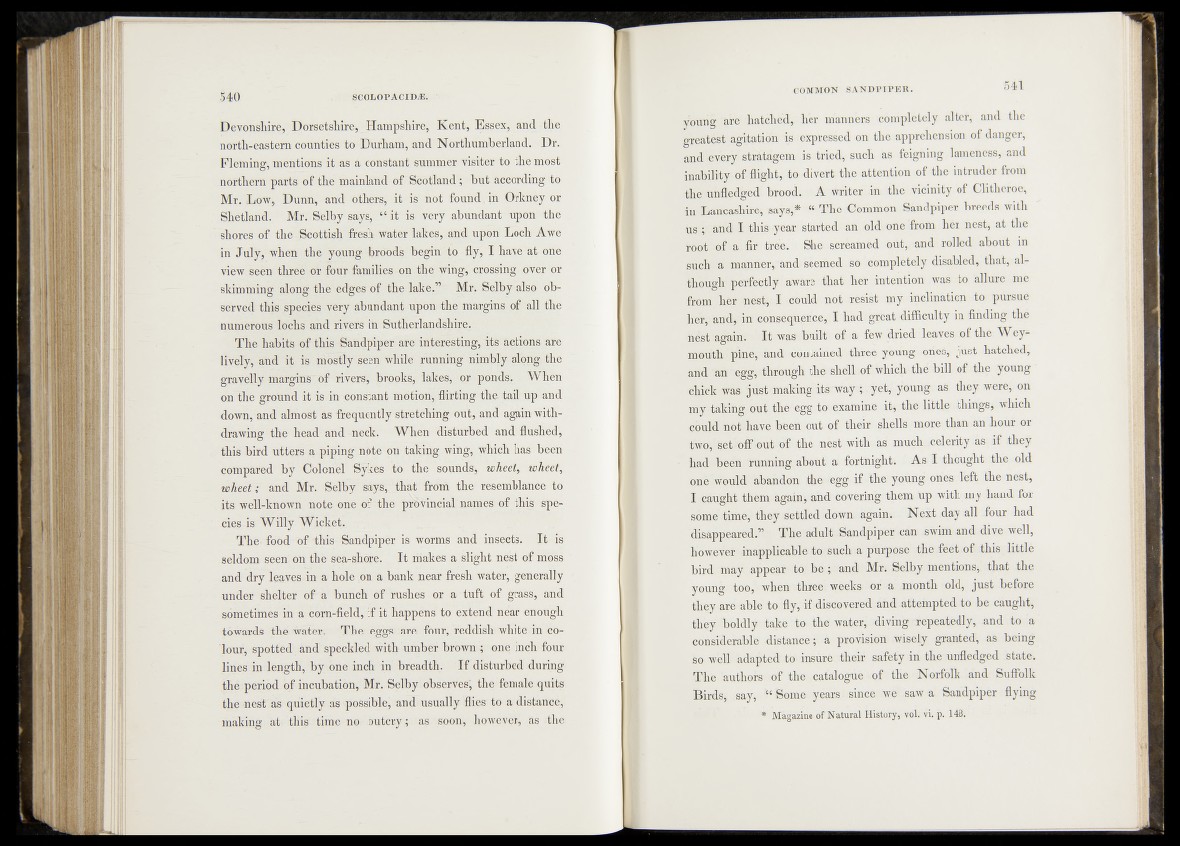
540 SCOLOPACIDÆ.
Devonshire, Dorsetshire, Hampshire, Kent/' Essex, and - the
north-eastern counties-to-Durham, and Northumberland'.-'* Dr.
Fleming, mentions it as à constant summer1 visiter to the mbs#*-
northern parts of the mainland of^^ÎGotïand^ butëwèbrding J|f|
Mr. Dow, Dunn, and others, -it^is not 'found, ffr Orkh<|vhor
Shetland. Mr. Selby says, "‘-fit is' vhry abundant ^upon the
shores of the ^Scottish freshwater lakes,-and upon Eocli Awe
in July, when the young- broods 'begin %jo flv, I ha^eT&t^me’,
yie-w seén threè or four famife^on- the wing, Grossing ||||t f e r
skimfning along thje'effges of the iake.,? Mr. Scp^jaiso. observed
this speci|s%<fry abundant liponthe margin's, .of1 all th e
numërous'lochs and rivers in Sutherlandshire,
The habits of this “•Sandpiper are ih teM s ^ û g ^ f^ ^ n fi'a re
lively, and it is mostly seen whifi^fun^g'h-imbly alon^tjfe
gravelly margins- of rivers, brooks,- 'lak||l| or£ponds. When
on the ground it is'inconstant motion, flirting the? tailmp'fan’d •
down, and almost as frequently Stretching- out, and again withdrawing
the head and ~hèèk%‘ • When-’-tlisturbecVtimgMHp
this bird utters a piping nptPgn tcdpng wing, which-has bheh
compared h jr Colonelv Syhes to the;isoundsf
wheel; and Mr. Selby says, „that front the- reseinblltrWto
its well-known note one of the provincial' nameg- of' this- spe-
hi©s-is Willy Wiékët. -
Thé food of 'this Sandpiper is worms and inséets*. - It is
seldom seen/on the sea-shore.' ,^ It makes a'slight ,nës| of iiïoss
and dry leaves<in a hole ,on a bank near fre,sh wàtèr,/generally
under shelter o f a bunch of'rushes or a ' tuft grass, and
sometimes in a corn-field, if it happens to extend near enough
towards the water: TharoggS' are four, reddish white in’colour,
spotted and' speckled with umber brown ■; one inch four
lines .in length, by one inch in breadth, If disturbed during-
thé.period of incubation, Mr, Selby i observes*, the female quits
the med as qmetly as ^possible, and-: usually flies to a distancé,
making at- this time no outcry •; ais soon, howeyei?, as the.
y®m§|are hatched, hér manners eémplètely alter, and the
^eatistTagitabic&i 'ia^expressedon tfee. apprehension of danger,
an^Ögï}ïs,trS%am B tried,<*,such as feigning lameness, and
inAilit}##'fli#it^to • divert thé attention of the intrudér from
theKuh%clgedi brood.-s A writer .in the vicinity of Clitheroe,
in?Dancashiref.^4^* Common Sandpiper breeds with ’
I 'th^yeaf^sta^ed' ah old one from hér nest, at the
ro btfoffefir ‘•creamed- tp t,tnnd rolled about in
shch a ^ ^ é ^ rj,fei?dlhSe|^ed^Ot#omplè,^ .y disabled, that, alher
intention was -to allure me
frOm ipelinatioji to pursue
he r , I hadf ^hatldifficulty in finding thé
the Wey?
mbilth pine, 4ndsic'©ntaifls|^^ifee. just hatched,
and "anfiegg^h’rough | S # # Lof whipMw&hiil of the young '
ehhk was -just'inakinf itsWay#; k$#$[$>uirg-- aS they were, on
myitp|ing*Öut the §jfgètê&'cxamihe little things, which
cdüMiifo^ivéhfeen 'more-than>an hour or
two,^etJo®id|^3bï the ne^tw|fe&|^ mucfficelerity -as if they
had runnmg/abtfüt a/Tbtt'ndghti As I thought the old
»bh'^w’ould^baM'on 4he|^gg*if^thefyqung. ones left the nest,
ijp u g h t themf-again'^'and covering theméip with my hand for
some time/ the^féttSi|down-S^gaimS^ Next <day all Tour had
'disappeared.«” ' The ïadulUSandpipeïieëm .swim-and dive well,
KöVimièf inapplicable' to*stiehca purpose'Th^Téet .of- .this. little
B ird rm a y appear :% fe ;^ a n d Mr.-Selby mentions,; that the
g.fl^é;l^fren>VtllléC'- weeks or a .month old, just before
•they are ablétb fly,'-ifid^>vered and .attempted to be caught,
they -boldly take to ^dwaker,'..diving frepeafedl^,and to a
considerable distance; a provision wisely granted, as being
i.: lo well adapted to-insure.1 thdr safety in the unfledged estate-.
The authors of the ^catalogue -of ‘ the Norfolk, and Suffolk
Birds, .say,. Some > years; since we saw a Sandpiper flying
• •*- Magazine of Natural History, vol. vi. p. 148.